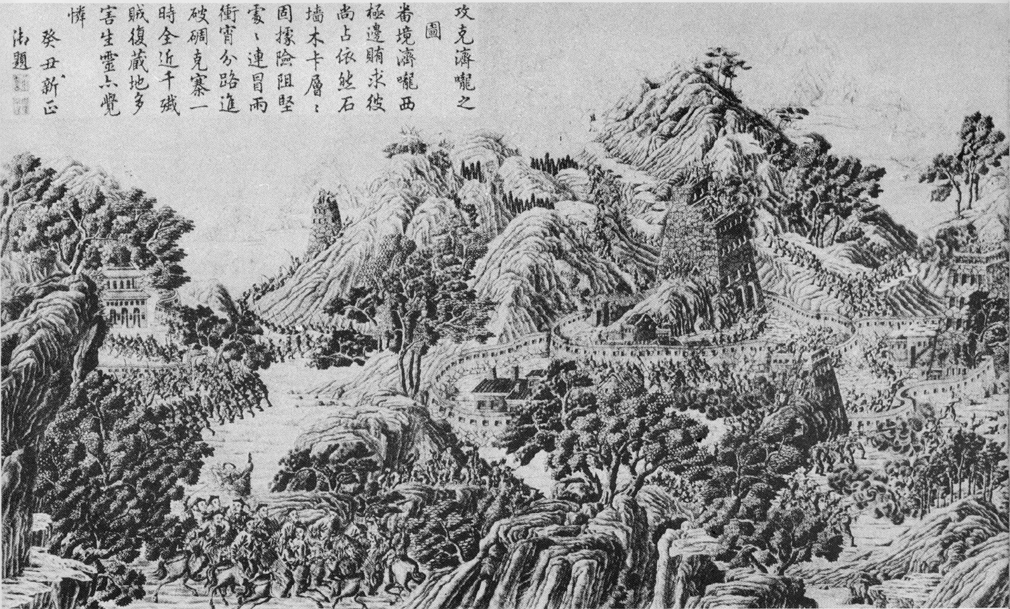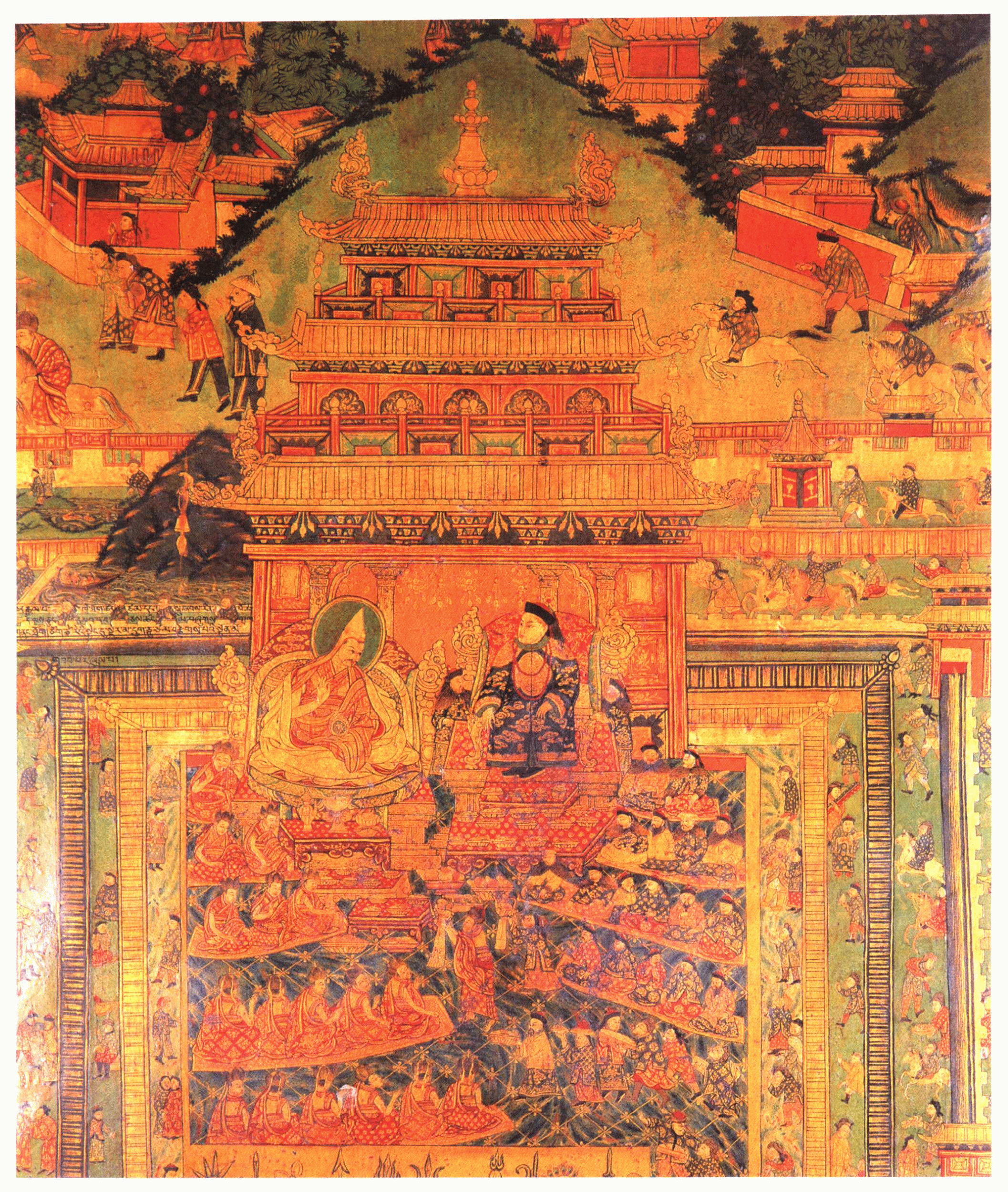|
Rasuwa Fort
Rasuwa Fort or Rasuwa Gadhi ( Nepali: ) is a historical fort ruin in the Rasuwa District of Nepal roughly at the border with Tibet, China. It is located along the Trishuli River north of the Nepalese town of Timure in Langtang National Park, yet 25 km south of the nearest locality of China at Gyirong Town. A trekking permit obtained in Kathmandu will allow tourists to visit the border, but not to cross the bridge into Tibet. History The area was the site of a three-day battle during the second campaign of Sino-Nepalese War in July 1792. In 1855 during the Rana dynasty when Jung Bahadur Rana invaded Qing-ruled Tibet in Nepalese–Tibetan War, the fort was constructed on the site. In 2012, Nepal and China agreed to open new border crossings, Rasuwagadhi site being one of the crossings. The fort was damaged during the construction of border crossing in 2013. In December 2014, the port of entry was opened near the fort. This route between China (via Gyirong Town / Kyirong on the ... [...More Info...] [...Related Items...] OR: [Wikipedia] [Google] [Baidu] |
Gyirong Town
Gyirong Town (; ; ne, केरुङ), also referred to as ''Kyirong'' or ''Kerung'', is situated in the southern part of Gyirong County in the Tibet Autonomous Region, China. The town is situated on the east bank of Gyirong River (Gyirong Zangbo), a tributary of the Trishuli River with an elevation of about . It has a subtropical mountain monsoon climate, with reasonable precipitation and warm weather, unusual for Tibet. The town is located south of the county seat Zongga and roughly north of Rasuwa Fort on the China-Nepal border where a border crossing into Nepal is located. In Gyirong Town, there is a village of ethnic Nepali referred to as Daman people. They are descendants of Nepalese Gurkha army centuries ago. Previously stateless, they were granted Chinese citizenship in 2003. History After the division of the Tibetan Empire, descendants of Songtsen Gampo fled to Gyirong and then founded the Gongtang Kingdom, whose ruins are now in Gyirong. During the first camp ... [...More Info...] [...Related Items...] OR: [Wikipedia] [Google] [Baidu] |
Rasuwa District
Rasuwa District ( ne, :ne:रसुवा जिल्ला, रसुवा जिल्ला is one of 13 districts of Bagmati Province and one of seventy-seven districts of Nepal. The district, with Dhunche as its district headquarters, covers an area of and has a population (2011) of 43,300. As per census 2011 total households in Rasuwa district is 9,778. It is the smallest district by area, among 16 districts in the ''Himalaya'' region of Nepal. Etymology Origin of its name had begun as 'Rasowa' which is believed to be derived as a combination of two Tibetan words ''ra'' (meaning: lambs) and ''sowa'' (meaning: grazing) as it was known for its lamb and grazing lands. And later people started to call it Rasuwa. Geography and climate Its territory has elevations ranging from from mean sea Level. Forests cover 31.43% of the land while 16.63% is always snow-covered. Steeply varying territory and plenty of natural blessings make Rasuwa a well-known tourist destination in Nepal ... [...More Info...] [...Related Items...] OR: [Wikipedia] [Google] [Baidu] |
Sino-Nepalese War
The Sino-Nepalese War ( ne, नेपाल-चीन युद्ध), also known as the Sino-Gorkha war and in Chinese the campaign of Gorkha (), was an invasion of Tibet by Nepal from 1788 to 1792. The war was initially fought between Nepalese Gorkhas and Tibetan armies over a trade dispute related to a long-standing problem of low-quality coins manufactured by Nepal for Tibet. The Nepalese Army under Bahadur Shah of Nepal, Bahadur Shah plundered Tibet under Qing rule and Tibetans tamangs signed the Treaty of Kerung paying annual tribute to Nepal. However, Tibetans requested for Chinese intervention and Sino-Tibetan forces under Fuk'anggan raided Nepal up to Nuwakot, Nuwakot, Nuwakot only to face a strong Nepalese counterattack. Thus, both countries signed the Treaty of Betrawati as a stalemate. The war ended in Nepal accepting terms dictated by China. Nepal became a Tributary state, tribute state of Qing (List of tributaries of Imperial China#Qing, Nepal maintains diplomacy ... [...More Info...] [...Related Items...] OR: [Wikipedia] [Google] [Baidu] |
Forts In Nepal ...
This is a partial list of forts in Nepal. Forts References External links Fort (Gadhi) Gallery {{Castles by country * Nepal Forts Forts Forts A fortification is a military construction or building designed for the defense of territories in warfare, and is also used to establish rule in a region during peacetime. The term is derived from Latin ''fortis'' ("strong") and ''facere'' ... [...More Info...] [...Related Items...] OR: [Wikipedia] [Google] [Baidu] |
Buildings And Structures In Rasuwa District
A building, or edifice, is an enclosed structure with a roof and walls standing more or less permanently in one place, such as a house or factory (although there's also portable buildings). Buildings come in a variety of sizes, shapes, and functions, and have been adapted throughout history for a wide number of factors, from building materials available, to weather conditions, land prices, ground conditions, specific uses, prestige, and aesthetic reasons. To better understand the term ''building'' compare the list of nonbuilding structures. Buildings serve several societal needs – primarily as shelter from weather, security, living space, privacy, to store belongings, and to comfortably live and work. A building as a shelter represents a physical division of the human habitat (a place of comfort and safety) and the ''outside'' (a place that at times may be harsh and harmful). Ever since the first cave paintings, buildings have also become objects or canvasses of much artistic ... [...More Info...] [...Related Items...] OR: [Wikipedia] [Google] [Baidu] |
Kodari
Kodari is a small village located at the border with Tibet-China. The village is located at the end–point of the Arniko Highway, which connects Kodari with the capital city of Kathmandu. Kathmandu is away from Kodari. Kodari is a major border crossing from Nepal into the Tibet Autonomous Region. Kodari is a part of Bhotekoshi rural municipality in Sindhupalchok District of Bagmati Province (previously Tatopani VDC of Bagmati Zone of Central Development Region; from 1990–2017). The other side is the town of Zhangmu (also known as Dram or Khasa in Nepali) located in Nyalam County, Shigatse Prefecture of the Tibet. History In ancient times, it was the starting point of a trans-Himalayan caravan route. Newar traders headed north from Kodari and after crossing Kuti pass turned east to continue their journey across the Tibetan Plateau to Lhasa. The construction of the Kathmandu-Kodari Road during the 1963-67 period. It was named Araniko Highway in Nepal and China National Hi ... [...More Info...] [...Related Items...] OR: [Wikipedia] [Google] [Baidu] |
Zhangmu
Zhangmu (also from Tibetan as Dram or Zham, from Nepali as Khasa) is a customs town and port of entry located in Nyalam County on the Nepal-China border, just uphill and across the Bhote Koshi River from the Nepalese town of Kodari. At above sea level, Zhangmu has mild and humid subtropical climate, which is a rarity for Tibet. History In ancient times, Kodari, the Nepalese village on the other side, was the starting point of a trans-Himalayan caravan route. Newar traders headed north from Kodari and after crossing Kuti pass turned east to continue their journey across the Tibetan Plateau to Lhasa. The construction of the Kathmandu-Kodari Road occurred during the 1963–67 period. It was named China National Highway 318 in China and Araniko Highway in Nepal. China has long planned and discussed building a railway connecting Lhasa with Zhangmu on the Nepal-China border, from 2008 onwards. It would be an extension of the Qinghai-Tibet Railway. However, as of late 2018 ... [...More Info...] [...Related Items...] OR: [Wikipedia] [Google] [Baidu] |
Port Of Entry
In general, a port of entry (POE) is a place where one may lawfully enter a country. It typically has border security staff and facilities to check passports and visas and to inspect luggage to assure that contraband is not imported. International airports are usually ports of entry, as are road and rail crossings on a land border. Seaports can be used as ports of entry only if a dedicated customs presence is posted there. The choice of whether to become a port of entry is up to the civil authority controlling the port. Airport of entry An airport of entry (AOE) is an airport that provides customs and immigration services for incoming flights. These services allow the airport to serve as an initial port of entry for foreign visitors arriving in a country. Terminology The word "international" in an airport's name usually means that it is an airport of entry, but many airports of entry do not use it. Airports of entry can range from large urban airports with heavy scheduled pas ... [...More Info...] [...Related Items...] OR: [Wikipedia] [Google] [Baidu] |
Tibet Under Qing Rule
Tibet under Qing rule refers to the Qing dynasty's relationship with Tibet from 1720 to 1912. The political status of Tibet during this period has been the subject of political debate. The Qing called Tibet a ''fanbang'' or ''fanshu'', which has usually been translated as "vassal state." Chinese authorities referred to Tibet as a vassal state up until the 1950s and then as an "integral" part of China. The de facto independent Tibetan government (1912–1951) and Tibetan exiles promote the status of independent nation with only a "priest and patron" relationship between the Dalai Lama and the Qing emperor. Western historians such as Melvyn Goldstein, Elliot Sperling, and Jaques Gernet have described Tibet during the Qing period as a protectorate, vassal state, tributary, or something similar. By 1642, Güshi Khan of Khoshut Khanate had reunified Tibet under the spiritual and temporal authority of the 5th Dalai Lama of the Gelug school. In 1653, the Dalai Lama travelled on a sta ... [...More Info...] [...Related Items...] OR: [Wikipedia] [Google] [Baidu] |
Jung Bahadur Rana
Maharaja Jung Bahadur Kunwar Ranaji, (born Bir Narsingh Kunwar ( ne, वीर नरसिंह कुँवर), 18 June 1817; popularly known as Jung Bahadur Rana (JBR, ne, जङ्गबहादुर राणा)) () belonging to the Kunwar family was a Khas Chhetri ruler of Nepal and founder of the Rana Regime in Nepal. Jung Bahadur took control of the government after killing an alleged usurper Gagan Singh, who was accused of plotting with the junior queen in 1846 to become prime minister by putting the queen's son on the throne. His original name was Bir Narsingh Kunwar but he was popularly known as Jang Bahadur, a name given to him by his maternal uncle Mathabar Singh Thapa. Mathabar Singh Thapa used to call Jang Bahadur ''Jangay'' for his boldness. His mother Ganesh Kumari was the daughter of Kaji Nain Singh Thapa, brother of Mukhtiyar Bhimsen Thapa of the then prominent ruling Thapa dynasty. During his lifetime, he eliminated the factional fighting at the cour ... [...More Info...] [...Related Items...] OR: [Wikipedia] [Google] [Baidu] |
Capture Of Resuoqiao
Capture may refer to: *Asteroid capture, a phenomenon in which an asteroid enters a stable orbit around another body *Capture, a software for lighting design, documentation and visualisation *"Capture" a song by Simon Townshend *Capture (band), an Australian electronicore band previously known as Capture the Crown *Capture (chess), to remove the opponent's piece from the board by taking it with one's own piece * Capture effect, a phenomenon in which only the stronger of two signals near the same FM frequency will be demodulated *Capture fishery, a wild fishery in which the aquatic life is not controlled and needs to be captured or fished * ''Capture'' (TV series), a reality show * ''The Capture'' (TV series), UK drama series *Electron capture, a nuclear reaction *Motion capture, the process of recording movement and translating that movement onto a digital model *Neutron capture, a nuclear reaction *Regulatory capture, situations in which a government agency created to act in the pub ... [...More Info...] [...Related Items...] OR: [Wikipedia] [Google] [Baidu] |







